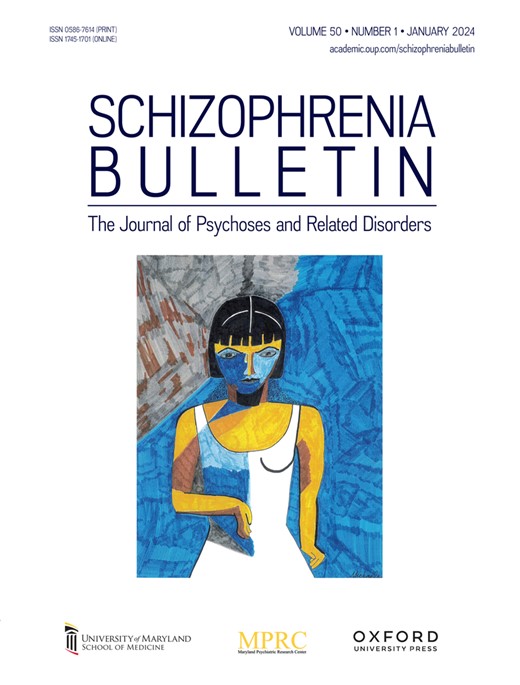慢性精神病计算机化听觉训练的药理学增强:一项单点双盲研究的初步发现
IF 5.3
1区 医学
Q1 PSYCHIATRY
引用次数: 0
摘要
计算机化听觉训练(AT)可适度改善精神分裂症患者的症状、认知和功能。我们评估了d-安非他明(AMPH)或美金刚(MEM)是否可以增加30小时AT的收益。方法服用抗精神病药物的慢性精神病患者68例;平均年龄47.03岁;M:F = 39:29)完成最多30次AT(每周2-3次;n = 50,完成30个疗程),分为3组:“AMPH组”(每次AT前1小时AMPH (5mg / po);“MEM组”(在整个训练过程中滴定至MEM bid 10mg并保持该剂量);“PBO组”(PBO与AMPH或MEM剂量相同)。主要(PANSS总、MCCB复合、WHODAS)和次要(PANSS阳性、PANSS阴性、YMRS、PHQ-9、PSYRATS)结果测量在基线、10、20和30次at和训练后12周获得。受试者和工作人员对药物识别(active/PBO)不知情。结果:三个主要结局中有一个的AMPH与PBO组间差异有统计学意义(WHODAS, P = 0.050;PANSS阳性、YMRS、PSYRATS, P′s≤0.027 ~ 0.049),5个次要临床结果中的3个(PANSS阳性、YMRS、PSYRATS, P≤0.027 ~ 0.049)。AMPH组(P值≤0.014 - 0.004)和MEM组(P值≤0.02 - 0.001)的主要和次要临床指标随着时间的推移检测到受试者内获益;其中一些不能经受多重比较的保守修正。未检测到症状加重;治疗满意度超出受试者预期。结论:结果好坏参半;与PBO相比,几种药物相关的获益表明,这些方案可能会增强at诱导的精神病患者的功能和临床改善,而不依赖于神经认知的改变。在更大的样本中进行评估似乎是合理的。本文章由计算机程序翻译,如有差异,请以英文原文为准。
Pharmacologic Augmentation of Computerized Auditory Training in Chronic Psychosis: Preliminary Findings From a Single-Site, Double-Blind Study
Background Computerized auditory training (AT) modestly improves symptoms, cognition, and functioning in schizophrenia. We assessed whether d-amphetamine (AMPH) or memantine (MEM) can enhance gains from 30-h of AT. Methods Antipsychotic-medicated individuals with chronic psychosis (n = 68; mean age 47.03y; M:F = 39:29) completed up to 30 AT sessions (2-3/week; n = 50 completed 30 sessions) in 3 groups: “AMPH group” (AMPH (5 mg po) 1-h before each AT session); “MEM group” (titrated to 10 mg MEM bid and maintained that dose throughout training); “PBO group” (PBO dosed identically to either AMPH or MEM). Primary (PANSS total, MCCB Composite, WHODAS) and secondary (PANSS positive, PANSS negative, YMRS, PHQ-9, PSYRATS) outcome measures were acquired at baseline, after 10, 20, and 30 AT sessions, and 12 weeks post-training. Pill identity (active/PBO) was blind to subjects and staff. Results Marginally significant between-group gains for AMPH vs PBO were detected for one of three primary outcomes (WHODAS, P =.050; but not PANSS total or MCCB Composite), and for 3 of 5 secondary clinical outcomes (PANSS positive, YMRS, PSYRATS, P’s≤.027–.049). Within-subject gains over time were detected for primary and secondary clinical measures for AMPH (P’s≤.014–.004) and MEM (P’s≤.02–.001) groups; some of these would not survive conservative correction for multiple comparisons. No measures detected symptom worsening; treatment satisfaction exceeded subjects’ expectations. Conclusions Results are mixed; drug-associated gains in several measures vs PBO suggest that these regimens may augment AT-induced functional and clinical improvement in psychosis patients, independent of changes in neurocognition. Assessment in larger samples seems warranted.
求助全文
通过发布文献求助,成功后即可免费获取论文全文。
去求助
来源期刊

Schizophrenia Bulletin
医学-精神病学
CiteScore
11.40
自引率
6.10%
发文量
163
审稿时长
4-8 weeks
期刊介绍:
Schizophrenia Bulletin seeks to review recent developments and empirically based hypotheses regarding the etiology and treatment of schizophrenia. We view the field as broad and deep, and will publish new knowledge ranging from the molecular basis to social and cultural factors. We will give new emphasis to translational reports which simultaneously highlight basic neurobiological mechanisms and clinical manifestations. Some of the Bulletin content is invited as special features or manuscripts organized as a theme by special guest editors. Most pages of the Bulletin are devoted to unsolicited manuscripts of high quality that report original data or where we can provide a special venue for a major study or workshop report. Supplement issues are sometimes provided for manuscripts reporting from a recent conference.
 求助内容:
求助内容: 应助结果提醒方式:
应助结果提醒方式:


